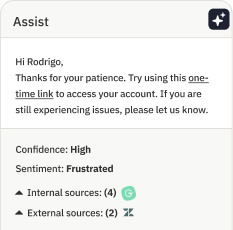Scale your customer support operations with BPO

In 2025, support teams are juggling more than ever. With the rise of AI, hybrid workforces, inflation, and labor shortages, companies are under pressure to not only meet customer expectations but also operate at peak efficiency. Business process outsourcing (BPO) is no longer just a tool for scaling headcount — it’s an essential strategy for optimizing operations, enhancing flexibility, and maintaining high customer satisfaction.
Why BPOs matter now more than ever
Today’s support leaders face increasingly complex challenges. Customers now expect personalized service, faster response times, and seamless experiences across multiple channels. Meanwhile, internal teams are often stretched thin, juggling repetitive tasks and seasonal demand spikes that strain resources.
This is where BPOs come in. A 2024 McKinsey survey found that 55% of companies are currently using BPOs, with nearly half planning to expand their outsourcing efforts over the next two years. Far from being just extra hands to handle tickets, modern BPOs provide the flexibility to manage overflow, seamlessly integrate with your tech stack (including AI tools), and uphold the high-quality service your team has built.
When strategically leveraged, BPOs free up your support teams to focus on what truly matters — solving complex issues, optimizing processes, and driving long-term performance.
Scaling with purpose
One of the greatest advantages of a BPO partnership is the ability to scale without sacrificing quality. Whether you’re navigating peak periods (think Black Friday or a new product launch) or managing an unexpected surge in customer inquiries, BPOs offer the elasticity your team needs. By offloading repetitive or routine tasks to a trusted partner, you can keep your in-house agents focused on higher-value interactions.
But scaling isn’t just about adding more people — it’s about doing more with less. BPOs can streamline operations by automating workflows, integrating with AI, and providing omnichannel support. This means you’re not just increasing headcount; you’re improving efficiency across the board.
Optimizing for operational efficiency
Beyond scaling, BPOs are a powerful lever for operational optimization. With the right partner, you can transform your support operations by leveraging their expertise, infrastructure, and ability to quickly adapt to new tools and trends. Today’s top-tier BPOs are well-versed in the latest technologies, including AI, which allows them to augment your support capabilities in ways that go beyond traditional outsourcing.
For instance, BPOs can help manage tiered support models, handle escalations, and support complex workflows. They can also seamlessly integrate with AI-powered solutions to provide more accurate responses, reduce handling time, and improve overall efficiency. As your team scales, these optimizations become crucial to maintaining service quality.
How to get the most out of your BPO partnership
To fully realize the benefits of BPO, it’s essential to approach the partnership strategically. Here are a few best practices for ensuring success:
- Set clear goals: Establish measurable performance metrics from the start. Whether it’s first response time, resolution time, or CSAT scores, having clear expectations will keep everyone aligned.
- Communicate regularly: Open lines of communication are key to a successful partnership. Regular check-ins and performance reviews will help you course-correct and stay on top of evolving customer needs.
- Leverage technology: Ensure your BPO partner is fully integrated into your existing tech stack. Tools like AI, workforce management platforms, and vendor management systems should be used to track performance and optimize processes in real time.
- Stay agile: Customer expectations and business needs change quickly. A flexible BPO partner who can pivot as needed is critical to staying competitive in today’s market.

Looking ahead: BPOs and AI
While some view AI as a threat to traditional outsourcing models, the reality is quite the opposite. In fact, the rise of AI is creating even more opportunities for BPOs to enhance and optimize support operations. By combining human expertise with AI-driven automation, BPOs can help businesses handle higher volumes of work with greater accuracy and efficiency.
BPOs are evolving to be true partners in the AI era, offering hybrid models that blend human and machine intelligence to deliver the best of both worlds. This means faster resolution times, more personalized customer interactions, and the ability to scale with precision.
Turn your BPOs into a strategic advantage
BPOs are essential for businesses that want to scale effectively and optimize their operations. By partnering with a trusted BPO, support teams can handle growing demand, streamline workflows, and leverage cutting-edge tools like AI to deliver exceptional customer experiences.
Whether you’re just starting to explore BPOs or looking to optimize an existing partnership, now is the time to rethink how outsourcing fits into your support strategy. The right BPO partner won’t just help you scale — they’ll help you thrive.





